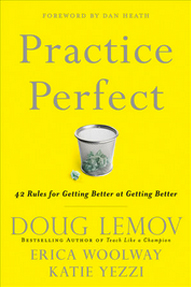Rules for developing talent with disciplined, deliberate, intelligent practice.
We’ve all heard the expression “practice makes perfect,” but then why doesn’t it always work? And why do we limit practice to things like the piano or tennis instead of what we really want to get better at like breaking bad habits, acing a meeting, advancing our careers, or leading people?
In Practice Perfect, authors and teaching experts Doug Lemov, Erica Woolway, and Katie Yezzi show us how we can get better at anything by engineering how we practice. The book debunks the myths and revolutionizes the way we approach and think about practice just as Lemov’s book Teach Like a Champion changed the way we teach.
By researching the latest in brain and behavioral science and in their work training teachers with Uncommon Schools, the authors found that what you do in practice matters as much if not more than how much you practice. There is a right way and a wrong way to practice. The right way involves breaking through assumptions, modeling excellent practice, using feedback, creating a culture of practice, making new skills stick, and hiring for practice.
Packed with stories of practice masters like Coach John Wooden, surgeon Atul Gawande, and basketball star Michael Jordan, Practice Perfect breaks down effective practice into 42 clear rules. They include:
- ENCODE SUCCESS: Engineer your practice activities so the right actions are encoded in your mental circuitry to become habit.
- PRACTICE THE 20: 80% of your success will come from 20% of your behaviors so practice the most impactful 20% to accomplish your goal.
- LET THE MIND FOLLOW THE BODY: Automate skills so you’ll use them before you consciously decide to.
- REPLACE YOUR PURPOSE WITH AN OBJECTIVE: Measure and define specifically what you’ll be able to do once mastering your goal.
- ISOLATE THE SKILL: Identify and name each technique you’ve identified as an important building block for peak performance.
